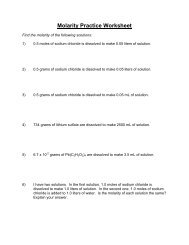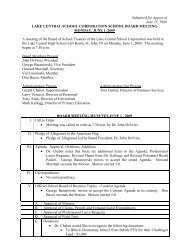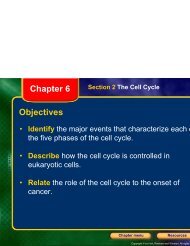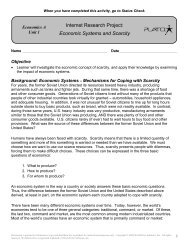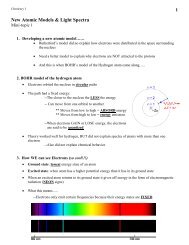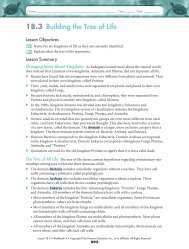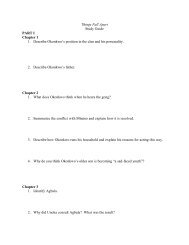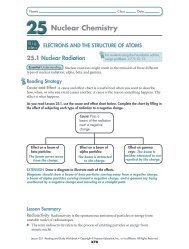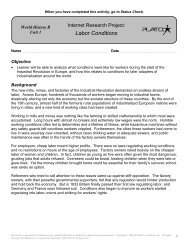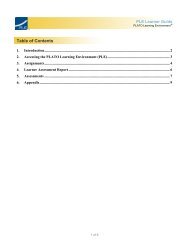Cultures of East Asia Section 1 - Lake Central High School
Cultures of East Asia Section 1 - Lake Central High School
Cultures of East Asia Section 1 - Lake Central High School
You also want an ePaper? Increase the reach of your titles
YUMPU automatically turns print PDFs into web optimized ePapers that Google loves.
<strong>Cultures</strong> <strong>of</strong> <strong>East</strong> <strong>Asia</strong> <strong>Section</strong> 1
<strong>Cultures</strong> <strong>of</strong> <strong>East</strong> <strong>Asia</strong> <strong>Section</strong> 1Preview• Starting Points Map: <strong>East</strong> <strong>Asia</strong>• Main Idea / Reading Focus• Sui and Tang Dynasties• Faces <strong>of</strong> History: Wu Zhao• The Song Dynasty• Map: Tang and Song DynastiesChinese Empires
<strong>Cultures</strong> <strong>of</strong> <strong>East</strong> <strong>Asia</strong> <strong>Section</strong> 1Preview, continued• Cultural Achievements• Quick Facts: Innovations• Prosperity and SocietyChinese Empires
<strong>Cultures</strong> <strong>of</strong> <strong>East</strong> <strong>Asia</strong> <strong>Section</strong> 1Click the icon to playListen to Historyaudio.Click the icon belowto connect to theInteractive Maps.
<strong>Cultures</strong> <strong>of</strong> <strong>East</strong> <strong>Asia</strong> <strong>Section</strong> 1Main IdeaChinese EmpiresThe Sui dynasty reunified China, after which the Tang and Songdynasties produced an age <strong>of</strong> prosperity and achievement.Reading Focus• How did the Sui and Tang dynasties reunify China?• How did the Song dynasty strengthen China?• What were some Tang and Song cultural achievements?• How was this period a time <strong>of</strong> prosperity and social change?
<strong>Cultures</strong> <strong>of</strong> <strong>East</strong> <strong>Asia</strong> <strong>Section</strong> 1Sui and Tang DynastiesThe Han dynasty ruled China from 206 BC to AD 220—more than 400years. After the dynasty collapsed, military leaders split China into rivalkingdoms. These events began a period <strong>of</strong> disorder and warfare thathistorians call the Period <strong>of</strong> Disunion.The Period <strong>of</strong> Disunion• Nomads invaded northern China,formed own kingdoms• Many northern Chinese fled southto region <strong>of</strong> Yangzi River• A number <strong>of</strong> southern dynastiesrose, fellCivilization Thrived• Despite these events, Chinesecivilization thrived, developed• Nomadic invaders in north adoptedaspects <strong>of</strong> Chinese civilization• Northern Chinese immigrants’culture blended with local culturesin south; arts, philosophy floweredThe Period <strong>of</strong> Disunion lasted more than 350 years, ending when anorthern ruler named Wendi reunified China, founding the Sui dynasty.
<strong>Cultures</strong> <strong>of</strong> <strong>East</strong> <strong>Asia</strong> <strong>Section</strong> 1<strong>Central</strong>ized Government• Wendi worked to buildcentralized government• Restored order, created newlegal code, reformedbureaucracyThe Sui DynastyGrand Canal• Greatest accomplishment <strong>of</strong> Suidynasty, completed during reign<strong>of</strong> Yangdi, Wendi’s son• 1,000 mile waterway linkednorthern, southern China• Created policies to provideadult males with land, ensureavailability <strong>of</strong> grain• Yangdi forced millions <strong>of</strong>peasants to work on canal; ledto discontent, rebellion• 618, Yangdi assassinated, Suidynasty ended
<strong>Cultures</strong> <strong>of</strong> <strong>East</strong> <strong>Asia</strong> <strong>Section</strong> 1Period <strong>of</strong> Brilliance• Tang dynasty ruled 618 to 907; Chinese influence spread• China experienced period <strong>of</strong> brilliance, prosperity, cultural achievement• Government, other institutions served as models across <strong>East</strong> <strong>Asia</strong>Built on Sui Foundations• Established capital at Chang’an, Sui capital• Second capital located at Luoyang• Government control remained centralized, based on bureaucracy <strong>of</strong> <strong>of</strong>ficialsCivil ServiceThe Tang Dynasty• To obtain talented <strong>of</strong>ficials, Tang expanded civil service examination system• People had to pass written exams to work for government• Created flexible law code; model for law codes in Korea, Japan
<strong>Cultures</strong> <strong>of</strong> <strong>East</strong> <strong>Asia</strong> <strong>Section</strong> 1Foreign Affairs• Tang expanded China, Chinese influence• Regained western lands in <strong>Central</strong> <strong>Asia</strong>, gained influence over Korea• Contact with Japan increased; Japanese scholars came to China tostudy• Expansion, increased contact with others grew foreign tradeExpansion• Much <strong>of</strong> expansion occurred during reign <strong>of</strong> Taizong, 626 to 649• Taizong relied on talented ministers to help govern• In addition to military conquests, Taizong had schools built to preparestudents for civil service exams• After his death, one <strong>of</strong> his sons became emperor
<strong>Cultures</strong> <strong>of</strong> <strong>East</strong> <strong>Asia</strong> <strong>Section</strong> 1Wu ZhaoNew emperor was weak, sickly• Emperor’s wife, Wu Zhao gained power• Following death <strong>of</strong> husband– Wu Zhao ruled through her sons– Eventually became emperor herself—the only woman to do soin Chinese history• Wu Zhao overthrown, 705– Dynasty reached height under Xuanzong– During reign, 712 to 756, empire prospered
<strong>Cultures</strong> <strong>of</strong> <strong>East</strong> <strong>Asia</strong> <strong>Section</strong> 1
<strong>Cultures</strong> <strong>of</strong> <strong>East</strong> <strong>Asia</strong> <strong>Section</strong> 1From India• Buddhism first came to China from India during Han times• During Period <strong>of</strong> Disunion many Chinese turned to Buddhism• Taught people could escape suffering, appealed to people in turmoilState Religion• Under Tang rule, Buddhism became state religion• Buddhist temples appeared across land, missionaries spread Buddhism• 400 to 845 in China, Age <strong>of</strong> Buddhism; ended when lost <strong>of</strong>ficial favorTang DeclineThe Age <strong>of</strong> Buddhism• 750s, decline began, government weak, nomadic invasions, rebellions• Military defeats lost Tang lands in <strong>Central</strong> <strong>Asia</strong> and the north• 907, emperor killed, Tang dynasty ended
<strong>Cultures</strong> <strong>of</strong> <strong>East</strong> <strong>Asia</strong> <strong>Section</strong> 1SummarizeHow did the Sui and Tang dynasties uniteand expand China?Answer(s): built centralized government;reformed laws and policies; built Grand Canal;Tang regained land in <strong>Central</strong> <strong>Asia</strong> and gainedinfluence over neighboring states; increasedcontact with other peoples
<strong>Cultures</strong> <strong>of</strong> <strong>East</strong> <strong>Asia</strong> <strong>Section</strong> 1After Tang DynastyThe Song DynastyGovernment and Civil Service• China split apart after Tangdynasty• Did not reunify until 960 withSong dynasty• Song ruled for about 300 years,created achievement, prosperity• Under Song, Chinesecivilization became mostadvanced in world• Song established capital atKaifeng, restored centralizedgovernment control• Enlarged governmentbureaucracy, reformed civilservice examination system• Neo-Confucianism gainedfavor, emphasizing Confucianethics, spiritual matters
<strong>Cultures</strong> <strong>of</strong> <strong>East</strong> <strong>Asia</strong> <strong>Section</strong> 1Civil Service Exams• Extremely difficult to pass; those who did became scholar-<strong>of</strong>ficials• Scholar-<strong>of</strong>ficials received good salary, were respected• Civil service exams became more open to ordinary people• Exams became pathway to gaining wealth, statusSouthern Song• Song rulers never regained northern, western lands lost by Tang• Tried to buy peace with threatening nomads by sending lavish gifts• 1120s, nomadic people, Jurchen, conquered northern China, foundedJin empire• Song continued in south as Southern Song dynasty 150 more years
<strong>Cultures</strong> <strong>of</strong> <strong>East</strong> <strong>Asia</strong> <strong>Section</strong> 1
<strong>Cultures</strong> <strong>of</strong> <strong>East</strong> <strong>Asia</strong> <strong>Section</strong> 1CompareHow did the Song strengthen China’sgovernment?Answer(s): established capital at Kaifeng andrestored centralized government control, enlargedbureaucracy, reformed civil service exam
<strong>Cultures</strong> <strong>of</strong> <strong>East</strong> <strong>Asia</strong> <strong>Section</strong> 1The Tang and Song dynasties were periods <strong>of</strong> great culturalachievement. Art and literature flourished, and many inventionsand advances occurred in science and technology.Literature and Art• Tang periodproduced some <strong>of</strong>China’s greatestpoets• Du Fu, Li Bo, twomost famous• Poems <strong>of</strong>Confucian ideals,joys <strong>of</strong> lifeCultural AchievementsPainting• Reached newheights• Wu Daozi, muralscelebratingBuddhism, nature• Landscapes <strong>of</strong>great beauty• Some used onlyblack inkArtisans• Exquisite objectsmade from clay• Tang: potteryfigurines, <strong>of</strong>ten togo in tombs• Song: excelled atmaking porcelain• Admired, soughtafter worldwide
<strong>Cultures</strong> <strong>of</strong> <strong>East</strong> <strong>Asia</strong> <strong>Section</strong> 1Architecture• Indian Buddhist templesinfluenced design <strong>of</strong> Chinesepagoda• Featured ro<strong>of</strong>s at each floorcurving upwards at cornersInventions and InnovationsInventions• During Tang, Song periods,China became a world leader intechnology, science• Gunpowder major invention,used in fireworks, weaponsMagnetic Compass• Major Tang technical advance• Uses Earth’s magnetic field toshow direction• Revolutionized sea travel,contributed to world explorationPrinting• Paper, ink invented earlier• Tang period, developedwoodblock printing• Text carved into wood, coatedwith ink, pressed on paper
<strong>Cultures</strong> <strong>of</strong> <strong>East</strong> <strong>Asia</strong> <strong>Section</strong> 1Moveable Type• Song dynasty invented another type <strong>of</strong> printing, moveable type• Uses blocks on which letters, characters carved• Blocks rearranged, reused to print many things• Faster than woodblock, spread to Europe, revolutionized printingPaper Money• Another Song invention• Had used bulky metal disks placed on strings• As economy grew, lighter, more useful form <strong>of</strong> currency developed• Paper money light, easy to use, quickly spread in use in China
<strong>Cultures</strong> <strong>of</strong> <strong>East</strong> <strong>Asia</strong> <strong>Section</strong> 1
<strong>Cultures</strong> <strong>of</strong> <strong>East</strong> <strong>Asia</strong> <strong>Section</strong> 1Identify Cause and EffectHow did Chinese innovations affect worldhistory?Answer(s): Gunpowder dramatically affected howwars were fought; the compass allowed for worldnavigation; printing innovations led to increasedsharing <strong>of</strong> ideas.
<strong>Cultures</strong> <strong>of</strong> <strong>East</strong> <strong>Asia</strong> <strong>Section</strong> 1Prosperity and SocietyIn addition to cultural achievements, the Tang and Song periods werea time <strong>of</strong> growth and prosperity.Agriculture• Chinese agriculture becamemore productive– New irrigation techniques– New variety <strong>of</strong> rice– Production <strong>of</strong> cotton, teaincreased• Increased food productioncontributed to populationgrowth• Tang population 60 million,Song population 100 millionTrade• Improvements in roads, canalsincreased trade within China• Foreign trade expanded,mostly over land routes likeSilk Roads• Late Tang: advances in sailing,shipbuilding helped sea trade• Song: merchants becameimportant in society; money,banking began to develop
<strong>Cultures</strong> <strong>of</strong> <strong>East</strong> <strong>Asia</strong> <strong>Section</strong> 1• As farming, trade grew so did China’s cities• China had largest cities in world at the time• Tang capital, Chang’an, population more than 1 million, many cultures• Song dynasty, several cities had million or more; sea trade caused port citiesto boom• Despite urban growth, most Chinese still lived, farmed in countrysideSocietyCity LifeWomen• Power <strong>of</strong> aristocratic familiesdeclined during period• New class developed, gentry• Included scholar-<strong>of</strong>ficials, leadinglandowners• Most still peasants, farmers• Paid most <strong>of</strong> taxes, little schooling• Status <strong>of</strong> women declined, mostvisibly in upper classes• Desire for small, dainty feet led tocustom <strong>of</strong> footbinding• Painful process to keep feet fromgrowing, deformed feet over time• Symbol <strong>of</strong> husband’s authority
<strong>Cultures</strong> <strong>of</strong> <strong>East</strong> <strong>Asia</strong> <strong>Section</strong> 1Draw ConclusionsHow did footbinding reflect changes inattitudes toward women in China?Answer(s): became symbol <strong>of</strong> husband'sauthority over wife; women's status declined





